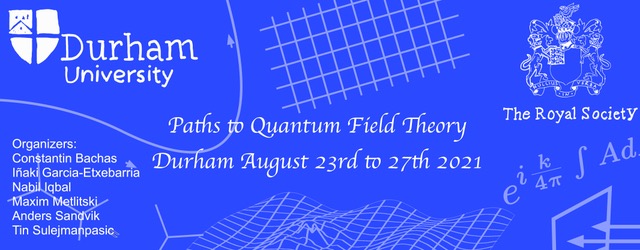- Compact style
- Indico style
- Indico style - inline minutes
- Indico style - numbered
- Indico style - numbered + minutes
- Indico Weeks View
Paths to Quantum Field Theory
→
Europe/London
Description
Paths to Quantum Field Theory is set to take place “in” Durham, United Kingdom during the period August 23rd to 27th 2021. The purpose of the workshop is to deliver a small amount of comprehensive talks, with plenty of background and accessible to diverse audiences. The talks and the atmosphere is aimed to educate and inform the audience about important topics relating to modern developments in theoretical physics across particle and condensed matter physics and involving analytical, numerical and hybrid approaches to problems. Given the current status of international travel, the workshop will be virtual, with scheduled opportunities for informal discussion.
Everyone interested is encouraged to register at the link below to receive information on how to attend the talks and discussions.
Invited speakers
Slava Rychkov (link to video)
Dam T. Son (link to video)
Adam Nahum (link to video)
Xie Chen (link to video)
Yuya Tanizaki (link to video)
David Tong (link to video)
Ian Affleck (link to video)
Uwe-Jens Wiese (link to video)
Sakura Schäfer-Nameki (link to video)
Fakher Assad (link to video)
Ribhu Kaul (link to video)
The organizers
Costas Bachas
Iñaki García Etxebarria
Nabil Iqbal
Max Metlitski
Anders Sandvik
Tin Sulejmanpasic
Participants
Abantika Ghosh
Achille Mauri
Adam Nahum
Adithya Suresh
Alessandro Mariani
Anders Sandvik
Andrea Ferrari
Aristos Donos
Arpit Das
Arthur Lipstein
Avner Karasik
Bharathkumar Radhakrishnan
Costas Bachas
Dam Son
Daniele Dorigoni
David Tong
Douglas Smith
Emilie Huffman
Fakher Assaad
Federica Albertini
Federico Carta
Francesco Parisen Toldin
Guangyu Xu
Hanqing Liu
Ian Affleck
Ilya Gruzberg
Ivano Basile
Iñaki García Etxebarria
Jiaxin Qiao
Jingxiang Wu
Joao Pinto Barros
Jose Sa
Jun Takahashi
Junchen Rong
Kuo-Wei Huang
Lakshya Bhardwaj
Luca Armando Nutricati
Lucca Marcon
Madalena Lemos
Marieke van Beest
Marten Reehorst
Mathew Bullimore
Max Metlitski
Mitch Weaver
Nabil Iqbal
Nakarin Lohitsiri
Nam Huy Nguyen
Nick Poovuttikul
Patrick Dorey
Pietro Benetti Genolini
Pongwit Srisangyingcharoen
Ribhu Kaul
Rudolfs Treilis
Sakura Schafer-Nameki
Simon Ross
Slava Rychkov
Sophie Saghar Hosseini
Stefano Cremonesi
Tin Sulejmanpasic
Tom Kennedy
Uwe-Jens Wiese
Victor Gorbenko
Wojciech Zakrzewski
Xie Chen
Yijian Zou
Yuya Tanizaki
Zheng-Quan Cui
Zhijin Li
Contact
